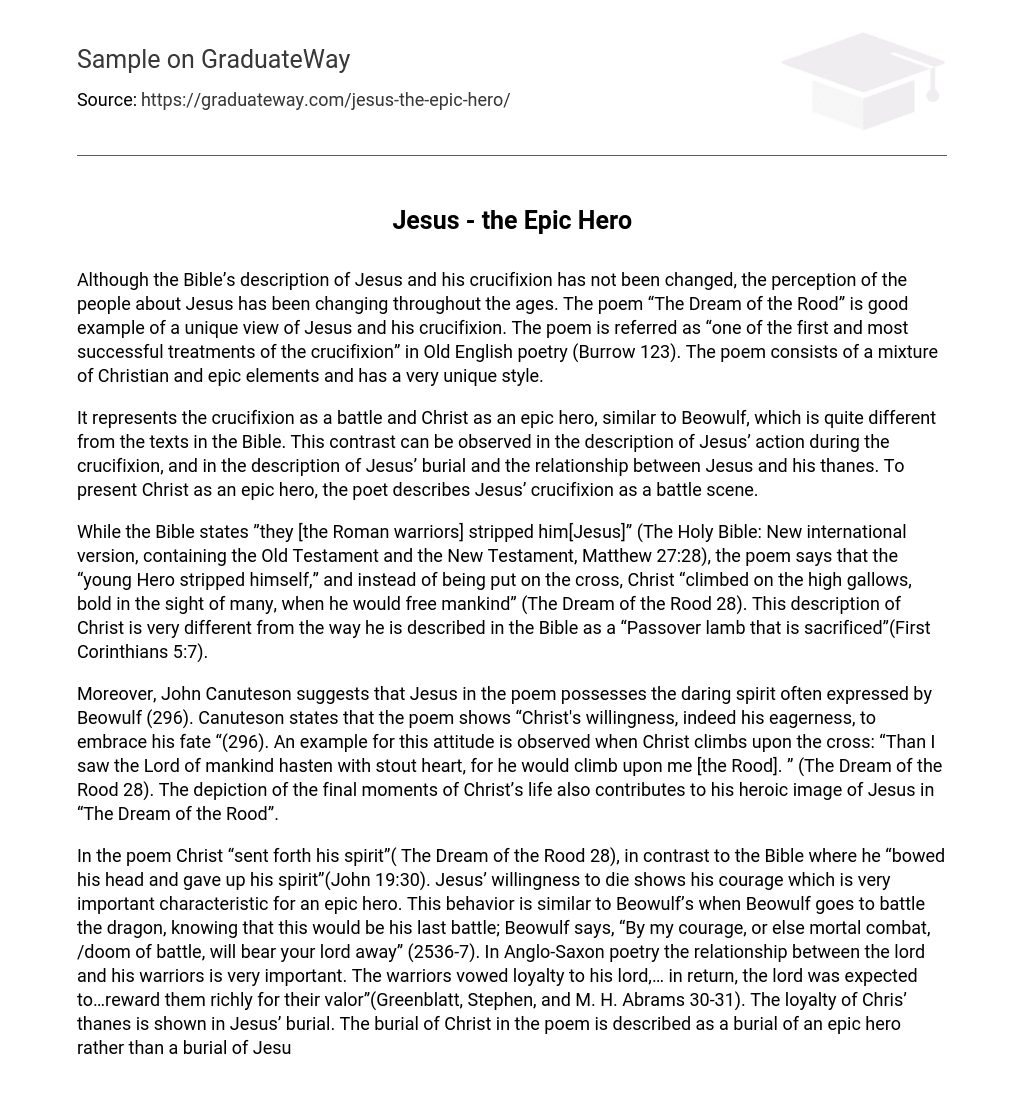While the Bible’s depiction of Jesus and his crucifixion remains unchanged, the perception of Jesus among people has evolved over time. “The Dream of the Rood” is an exemplary poem that offers a distinct perspective on Jesus and his crucifixion. This poem is hailed as one of the earliest and most accomplished portrayals of the crucifixion in Old English poetry (Burrow 123). It combines Christian and epic elements, resulting in a truly distinctive style.
The poet characterizes Christ as an epic hero engaged in battle during the portrayal of the crucifixion, which differs from biblical accounts. This distinction is evident through Jesus’ actions during his crucifixion and burial, as well as his association with his disciples. The poet envisions the crucifixion as a battlefield to depict Christ as an epic hero.
Jesus’ portrayal in different texts varies significantly. In the Holy Bible, it is stated that Roman warriors stripped him (New international version, containing the Old Testament and the New Testament, Matthew 27:28). However, The Dream of the Rood poem presents a contrasting depiction where Jesus willingly strips himself and fearlessly ascends on the gallows to liberate humanity (The Dream of the Rood 28). This representation differs greatly from Corinthians where he is compared to a sacrificed Passover lamb (First Corinthians 5:7).
In addition, John Canuteson suggests that Jesus in the poem possesses a bold spirit, which is often expressed by Beowulf (296). Canuteson states that the poem demonstrates “Christ’s willingness, indeed his eagerness, to accept his destiny” (296). This attitude is exemplified when Christ ascends the cross: “I saw the Lord of mankind hasten with a brave heart, for he wanted to climb upon me [the Rood]” (The Dream of the Rood 28). The portrayal of Christ’s final moments also contributes to the heroic image of Jesus in “The Dream of the Rood.”
The poem “The Dream of the Rood” portrays Christ as “sending forth his spirit,” which contrasts with the biblical account where he “bowed his head and gave up his spirit” (John 19:30). This demonstrates Jesus’ courage, an important characteristic of an epic hero. This bravery is reminiscent of Beowulf’s final battle with the dragon, knowing it would be his last. Beowulf declares, “By my courage, or else mortal combat, / doom of battle, will bear your lord away” (2536-7). In Anglo-Saxon poetry, the lord-warrior relationship is significant. Warriors pledged loyalty to their lord and in return expected rich rewards for their valor (Greenblatt, Stephen, and M. H. Abrams 30-31). The loyalty of Christ’s followers is evident in his burial. The poem portrays Christ’s burial as that of an epic hero rather than the biblical account which simply states that he was buried in a tomb near his crucifixion site (John 19:41-42). In “The Dream of the Rood,” Jesus’ burial resembles that of a great warrior like Beowulf. Beowulf’s people constructed “a mound on a headland,… their hero’s memorial” (3156,3160).The poem “The Dream of the Rood” depicts Jesus’ followers constructing a dwelling for him within the body of his killer, using shining stone. They then honor their Lord by singing a mournful song to him. In return, Jesus, acting as a benevolent king, provides sustenance and eternal abode for his loyal warriors.
“The Dream of the Rood” combines Germanic and Christian elements, showcasing the Anglo-Saxon’s assimilation of Christianity into their heroic ideals (Greenblatt, Stephen, and M. H. Abrams 5). While the poem draws from scripture, it portrays Jesus not as a “Passover lamb,” but as a fearless Germanic epic hero who is willing to sacrifice his life for his people, promising them eternal life as a reward for their loyalty.
Furthermore, Dockray-Miller argues that in “The Dream of the Rood,” Christ is portrayed as a lordly Anglo-Saxon warrior who is accompanied by his loyal thanes and later bestows rewards upon them at a heavenly feast of glory (par. 7).
Works Cited
- Burrow, John A.. “An approach to ‘The Dream of the Rood . ’” Neophilologus 43. 1 (1959): 123-133. Springerlink. Web. 18 Nov. 2010.
- Canuteson, John. “The Crucifixion and the Second Coming in ‘The Dream of the Rood. ’” Modern Philology 66. 4 (1969): 293-297. JStor. Web. 20 Nov. 2010.
- Dockray-Miller, Mary. “The Feminized Cross of ‘The Dream of the Rood. ’” Philogical Quarterly, Vol 76. 1997, pp. 1 and 3. HighBeam Research. Web. 18 Nov. 2010.
- Greenblatt, Stephen, and M. H. Abrams. The Norton anthology of English literature . 8th ed. New York: W. W. Norton, 2006. Print.
- “Beowulf. ” The Norton anthology of English literature . 8th ed. New York: W. W. Norton, 2006. Print.
- “The Dream of the Rood. ” The Norton anthology of English literature . 8th ed. New York: W. W. Norton, 2006. Print.
- The Holy Bible: New international version, containing the Old Testament and the New Testament. Grand Rapids, MI: Zondervan Bible Publishers, 1988. Print.





